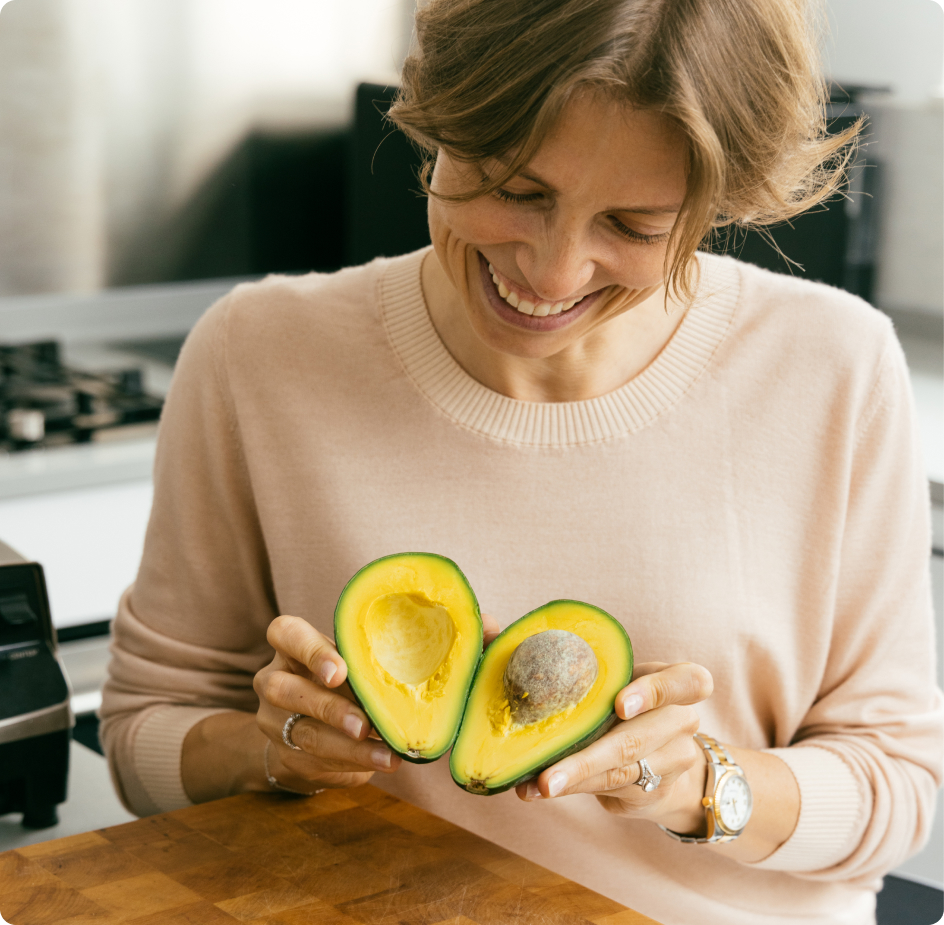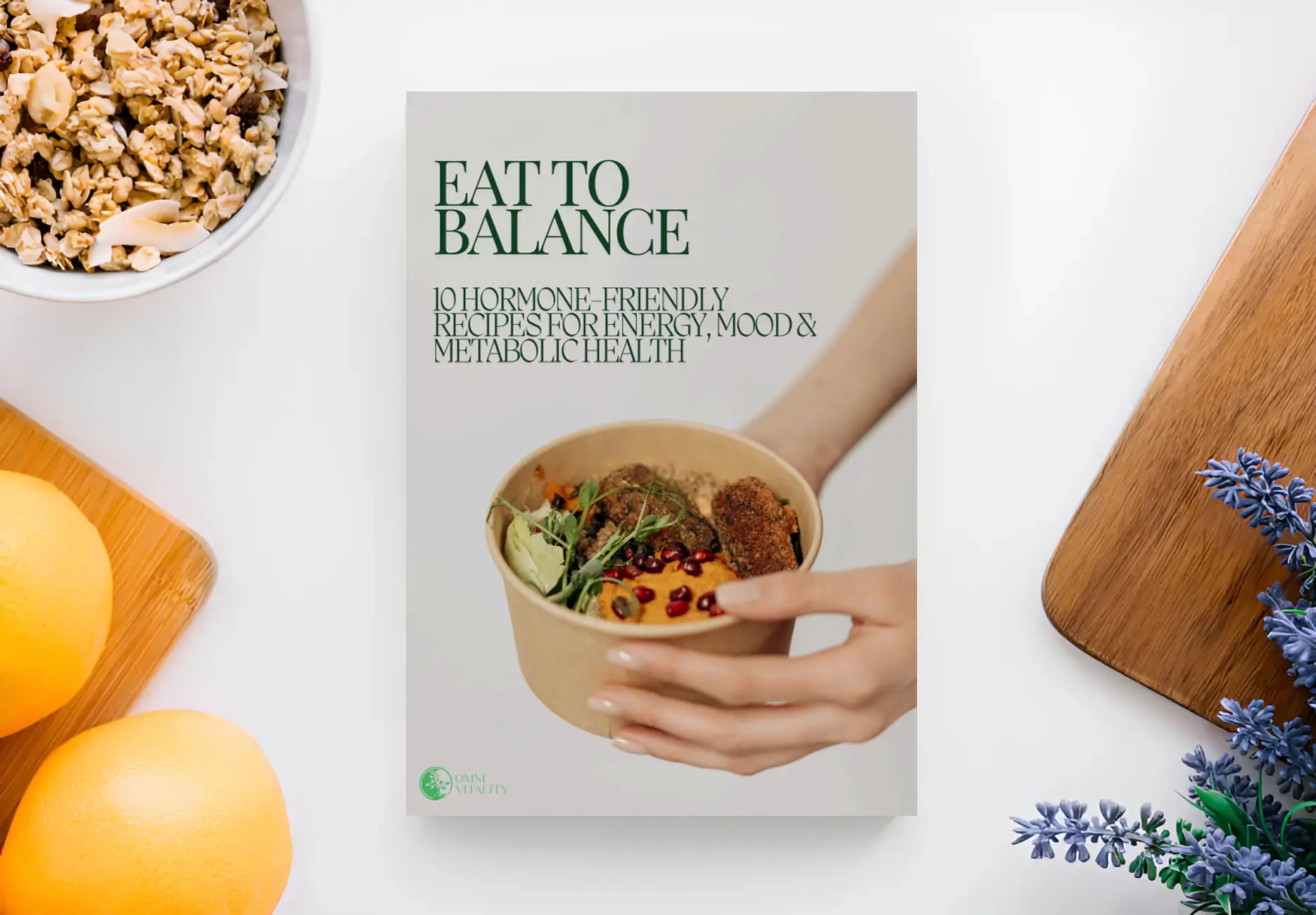
Got Pain?
Life balance - reality or utopia? How can a busy woman achieve a balance between family, social, and career commitments?
The life of a busy modern woman looks like a marathon - she tries to manage so many things at once while also dealing with constant changes as her hormones fluctuate daily, monthly, and throughout her lifetime.
The result? For many women, this combination of superwomen expectations, hormonal fluctuations, and misinformation about women's health means feeling cranky, exhausted, unsexy and having to endure chronic pain. Women often ignore these problems. They think that headaches, menstrual pain, and stomach pain are just inconveniences we must put up with. That they are just a normal part of being a woman. Searching for quick answers, women turn to medications, such as painkillers, to take the pain away. Yet, they forget that long-term use of these drugs has damaging consequences and may further contribute to their hormonal crisis.
We, women, are worth much more! We deserve to feel happy, loved, alive, and sexy! It's time to change and reconnect to our bodies, finding happiness inside and out!
If your inner desire to find answers to how you feel led you to me, it is a sign you are ready for change, and by searching for answers here, you have already taken the first step on your journey to a new you.
Remember, women are blessed with a body that can create and maintain a hormonal symphony month after month. We need to give it a helping help to re-establish this harmony. Together, we can find the unique magic formula to achieve balance.

Hello, I'm Katia, a Nutritional Therapist and women's health specialist.
When I came to nutrition therapy in my thirties, I was in a terrible state: overweight, frustrated, exhausted, and struggling with bad menstrual cramps. And I know I'm not alone - many modern women can relate to feeling like I did and having to put their lives back together piece by piece. Through my personal experience, I learned how to succeed at finding balance in my life and restoring my health and happiness. I now want to share my experience and expertise with others looking to turn their lives around.
I help women struggling with menstrual pain, excess weight, lack of confidence, and other consequences of hormonal imbalance.
I want to support you by showing you it is possible to live happily and healthily without medications and in the most natural way.

What are menstrual cramps?
Do you have abdominal and pelvic pain before or during your period? You are not alone. According to research, 95% of women experience menstrual cramps. But are you one of the 15% of women that seek help because they realise that period pains affect their everyday activities? I hope you are!
What factors could lead to period pains? Let's explore some of them below:
- Uncomfortable and painful contractions can occur when your uterus contracts to squeeze the lining away from your uterine wall and allow it to exit the body through the vagina as menstruation.
- An imbalance in sex hormones can influence menstrual pains by affecting how heavy and clotty your periods are.
- Excessive inflammation can strengthen uterine contractions, leading to pain before or during your period.
Facts about period pain:
- Period pain affects between 45% and 95% of menstruating women.
- Seventy-six per cent of women think menstrual pain is a normal part of their lives, and only 15% try to find explanations and solutions.
- While pain is usually most substantial in the lower abdomen, it can also radiate to the back and thighs.
- Another common term for period pain is dysmenorrhea. There are two different types of it: primary and secondary. Primary dysmenorrhea occurs among young women who don't start menstruating by age fifteen. Secondary dysmenorrhea is usually caused by endometriosis, uterine fibroids or other hormonal conditions. In the case of secondary dysmenorrhea, the pain is not restricted to the time of menstruation and can occur throughout the cycle. Menstruation may become heavier and more prolonged, and intercourse may be painful.
- Period pain can be accompanied by bloating, tender breasts, swollen stomach, lack of concentration, mood swings, clumsiness, and fatigue. These are just some symptoms that are often referred to as PMS.
- Painful periods are not the verdict. Look here, and you will find a list of natural pain-period solutions I created for you.
Start your health journey today
What are some of the hormonal imbalances that can cause menstrual cramps?
Let's look closer at these four areas of women's health that can suffer as a consequence of the hormonal imbalance
Endometriosis
Endometriosis is a condition when cells that form the lining of the uterus grow outside the uterus where they do not belong. When you menstruate, these bleed the same way they would inside the uterus. As a result, areas surrounding these cells may become inflamed or swollen. It may even lead to scar tissue and lesions.
Women with endometriosis can experience painful menstrual cramps, ovulation pain, heavy periods, spotting between periods, pain during or after sex, pelvic pain, and lower back pain. Pain can accompany fatigue, diarrhoea, constipation, bloating, or nausea.
If you have this condition and experience any of these endometriosis cramps, the below Endometriosis solutions may naturally help reduce endometriosis pain:
- Love your liver
-
it plays an essential role in the hormone balance. Support your liver by:
- Eating plenty of crucifers like broccoli and cauliflower;
- Including sulphur-containing vegs like onion, garlic, and leeks in your meals;
- Enriching your diet with other liver-loving foods like carrots, lemons, artichokes, beets, watercress, and dandelion greens;
- Using a variety of herbs and spices;
- Reducing your alcohol intake and minimising exposure to environmental chemicals that can make the liver work overtime (e.g., plastics, cosmetics, household cleaning products, etc.)
- Fix your gut
-
Once the liver processes oestrogen for elimination, it's up to your gut to move it out of the body. If you are constipated, there is a good chance that this isn't happening, and your hormones are going back into circulation. You can support your gut by:
- Adding more fibre to your diet. Fibre is excellent for helping balance sex hormones; I want you to have lots of fibre! Fibre helps move the bowels; in other words, it helps you poo. Why is it important? Because when we poo, we free the body not just of toxins but also of used-up hormones. Fibre is found in many plant foods, including whole grains, nuts & seeds, fruits & veggies. For example, one cup of broccoli provides 5g of fibre, and 1tbsp of flaxseed offers 2g of fibre. If you are not used to fibre, increase fibre intake slowly to allow your body to build a tolerance.
- Taking two tablespoons of freshly ground flax seeds daily to help bind and eliminate used-up hormones.
- Drinking two litres of water daily. This is crucial for healthy bowel movements as fibre combines with water forming a soft gel, allowing for more effortless bowel evacuation.
- Consumption of fermented foods can further support successful hormone detoxification by helping balance the gut's bacterial composition. Add such fermented foods as sauerkraut, miso, and tempeh to keep your gut healthy.
- Fall in love with oily fish
-
Oily fish, such as salmon, mackerel, and sardines, contains omega:3 fats, which can inhibit proinflammatory compounds that mediate pain and inflammation. These fats have been shown to reduce pain, similar to medication.
- Eat oily fish two to three times a week to benefit from omega:3 fats.
- If you are a vegetarian, omega:3 fats can also be obtained from such plant sources as flaxseed, chia seeds, and walnuts.
- You may also benefit from supplementing omega:3, which your nutritional therapist can assist with.
PCOS
Polycystic ovary syndrome (PCOS) is the most common female endocrine disorder seen in women today. It is another female issue that results from an imbalance of hormones.
PCOS is linked to many health complications outside of reproductive health, including diabetes and cardiovascular disease. It is relatively common, and 1 in 10 women of reproductive age struggle with PCOS.
No single PCOS test exists, just a long list of symptoms and test results that create a PCOS profile.
Do any of these PCOS symptoms sound familiar to you?
- Are you putting on weight, especially around the middle?
- Can't lose weight?
- Do you have unwanted hair growth, or are you losing hair on your head?
- Do you have breast pain?
- Do you suffer from adult acne?
- Can't get pregnant?
- Are you feeling low all the time?
- Are you experiencing persistent PCOS pain in various body parts, including headaches, pelvic pain, severe period pain and abdominal pain?
While there is a genetic component at the heart of PCOS, which often results in women having higher levels of the male hormone testosterone, this condition is very responsive to dietary and lifestyle changes.
What can you do to reduce PCOS symptoms and cramps?
- Balance your blood sugar
-
PCOS is strongly linked with insulin resistance and is often found in women with diabetes. Insulin influences sex hormones, and if you want to begin the processes of balancing out oestrogen, progesterone, and testosterone, you first need to get your blood sugar under control. You can reduce your insulin levels by eating foods that do not take you on a blood sugar rollercoaster.
Here are a few simple steps to help you achieve this:
- Replace processed carbs with low glycaemic load (GL) ones. Carbohydrate-containing foods - such as bread, pasta, rice, quinoa, legumes, vegetables, etc. - are broken down by the body to glucose (sugar), supplying the brain and other organs with the necessary energy. While all carbohydrates are made of sugars, the same quantity of carbohydrates affects blood sugar levels differently. To minimise large blood sugar fluctuations, we should get our carbs from foods that slowly release sugar into the bloodstream rather than from foods that cause blood sugar levels to surge. Non-starchy vegetables, pulses, sweet potato, pumpkin, brown rice, quinoa, etc., are foods that release their sugar slowly, help keep blood sugar levels stable and have low GL. Foods that can cause a spike in blood sugar levels are white pasta, cakes, cookies, white rice, white potatoes, etc., referred to as high-GL foods. To help smoothen blood sugar fluctuations, focus on low GL sources of carbohydrates in your meal and snacks.
- Include protein with every meal and snack. Protein takes longer to digest, slowing down glucose's release into the bloodstream. Eggs, chicken, seafood, and meat are all great sources of animal proteins. For vegetarians, look at such protein sources as tofu, tempeh, nuts and seeds, and legumes, and add them to every meal.
- Start your meals with colourful non-starchy vegetables. It can be broccoli, carrots, celery, beans, mushrooms, salad, etc. Eat vegetables before other products; fibre in vegetables helps slow the speed with which the sugars from your meal are released into your bloodstream.
- Manage stress (see below). During stress, our body releases chemical messengers (hormones such as cortisol) that increase our blood sugar. Cortisol is also involved in replenishing depleted energy stores – it initiates cravings and converts food into stores of glucose and fat.
- Enjoy leafy greens, which contain magnesium - a critical mineral for glucose transport and metabolism. To obtain more magnesium from your diet, eat more green leafy vegetables, like cooked Swiss chard, spinach, kale, etc.
- Manage stress
-
Stress contributes to PCOS, as women who are under a lot of stress cannot produce hormones in a balanced manner. While we can't always eliminate the stressors in our lives, we can change how our body responds to them. The techniques below will help lower your stress levels.
- Yoga, breathing exercises, journaling, and meditation have the power to reduce the levels of the stress hormone cortisol. And even simple practices like connecting with loved ones, finding something to laugh about, getting yourself grounded in nature, or listening to your favourite song can make one more resilient when faced with stress. Choose a practice that works for you.
- Make it regular. Consistency is essential as stress management practices show an increase in effectiveness in stress reduction when they are undertaken over more extended periods. Set aside 5-10 minutes daily to practice what works for you.
- Get moving
-
Using your muscles helps burn glucose and improves the way insulin works.
- Take a brisk walk after meals. A simple walk can reduce the impact of your meal on your blood sugar levels and insulin response.
- Participate in moderate resistance exercise two to three times a week. While resistance exercise has less of an initial effect on blood sugar levels than aerobic exercise, it has a more prolonged effect, helping you manage blood sugar over many hours following this type of exercise.
- Break up your sitting time every 30 minutes and find a way to move for just a few minutes. Do a few quick squats at the desk or walk to the kitchen to get some water.
Fibroids
Fibroids are benign (non-cancerous) growths on or within the uterus walls that can cause irregular, heavy, and painful periods.
We know that fibroids shrink during menopause when our oestrogen levels reduce. This is because fibroids have oestrogen receptors. Oestrogens are proliferative, which means they can cause cells to grow. Excess oestrogen in the body thus contributes to fibroids' growth. Statistically, 80% of women have fibroids.
What can you do today to address the hormonal imbalances contributing to fibroids?
- Remember, your liver plays an essential role in hormonal balance
-
Below are simple steps you can take today to support your liver:
- Choose a diet rich in green vegetables and crucifers like broccoli and cauliflower.
- Add sulphur-containing vegetables like onion, garlic, and leeks to your meals.
- Remember that carrots, lemons, artichokes, beets, watercress, and dandelion greens are all foods that our liver thrives on.
- Use plenty of herbs and spices - add them to your stews, stir-fries and even your morning smoothies.
- Detox your lifestyle by cutting-out alcohol and finding cleaner alternatives to plastics, cosmetics, and household cleaning products. Toss the plastics, replacing them with glass and steel containers. Replace your Teflon pans with cast iron ones. Eat organic where possible, especially when it comes to animal products.
- Manage your blood glucose level
-
Fibroids can be triggered or worsened by insulin resistance. Rising insulin stimulate cell proliferation in uterine fibroid tissue. You can reduce your insulin level by:
- Replacing simple carbs, such as white pasta, cakes, cookies, white rice, and white potatoes, with non-starchy vegetables, pulses, sweet potato, pumpkin, brown rice, or quinoa. These changes can help smooth out the blood sugar fluctuations and won't constantly be spiking your insulin levels.
- Remember to have protein with all your meals: chicken, seafood, and eggs are examples of animal sources of protein. Or, if you are vegetarian, try tofu, nuts, and legumes as an alternative source of protein.
- Start your meal with colourful non-starchy vegetables. It can be broccoli, artichoke, baby corn, beans, salad, or tomatoes. The list goes on! Fibrous veggies will help create a "net" in your stomach to catch the glucose from your meal, so it does not escape into your bloodstream too fast.
- Find ways to manage stress. Remember, we can't always avoid the stressors, but we can teach our bodies to respond to these stressors in a way that does not cause havoc on our hormonal balance. Choose whatever it is that works for you and practice it every single day to see the results. For some of you, it may be yoga or meditation; for others - having fun with your friends, journaling or taking a walk in the mountains.
- Add more green leafy vegetables as a natural source of magnesium - a critical mineral to transport glucose and support metabolism. Spinach, kale, and collard greens are just some of the examples for you to choose from.
- Move more. Every time you have a chance to move, walk, stretch, and stand up for a few minutes! If you sit at the computer all day, do a few squats at the desk, or walk to another room. Simple movement can help our muscles burn glucose and improve how insulin works.
Speak to your doctor if you have hefty periods or periods that last a long time, clots in your menstrual blood that look like liver, a swollen stomach, or if you are going to the loo more frequently and have a backache.
PMS
Premenstrual syndrome (PMS) is a condition with emotional, physical, and behavioural symptoms that many women get about a week or two before their period. PMS is a widespread concern. Studies show that almost 90% of women of reproductive age experience psychological and physical symptoms of PMS.
PMS symptoms
Did you know that there are over 150 symptoms associated with PMS? The specific combination of symptoms is very individual, but common complaints include mood swings, feeling anxious and irritable, experiencing cravings, or feeling washed out. Are you getting tender breasts, water retention, bloating, and feeling forgetful, clumsy, or depressed? Experiencing cravings and gaining weight before your period? Or perhaps you are suffering from cyclical cramps and pain?
Causes of PMS cramps and other symptoms
PMS can signify an imbalance in sex hormones, oestrogen, progesterone, or inflammation. While many symptoms of PMS are already discussed here, let us now focus on menstrual cramps that affect many women.
During menstruation, the uterus contracts to squeeze the lining prepared for a potential pregnancy out of the body. If you experience PMS cramps, it could be that these contractions are too strong. Cramps usually feel like throbbing pains in your lower belly. They can start a few days before your period comes and sometimes continue throughout your period. Cramps can worsen during the first few days of your period when your flow is the heaviest.
Menstrual cramps are widespread, painful, and irritating, but there are many ways to help yourself during this period and relieve the situation, which I want to share with you below.
What can you do at home to get PMS cramps relief:
- Eat the right kinds of carbs
- Don't be afraid of carbs: complex, unrefined carbs such as whole grains and vegetables can help balance your blood sugar.
- Eat plenty of vegetables and some berries
- Broccoli and cauliflower are perfect for PMS sufferers as they contain compounds that can mop up excess oestrogens and help to calm menstrual cramps.
- Out with the bad, in with the good kind of fat
- Cut back on vegetable oils (such as sunflower oil) and hydrogenated fats (found in processed foods like biscuits and junk foods), and replace these with essential fats found in oily fish, nuts, seeds, and olive oil. These right kinds of oils can help balance inflammation and improve hormonal communication.
- Bulk up your consumption of fibre
- Fibre is contained in many plant foods, including whole grains, nuts & seeds, fruits & veggies. It plays a crucial role in balancing female hormones. Aim for 35g of fibre daily but build up your fibre levels slowly to avoid discomfort. For example, one cup of broccoli provides 5g of fibre, and 1tbsp of flaxseed contains 2g of fibre.
- Cut out the alcohol and smoking, and ditch household toxins which all tax the liver
- The liver is one of the critical organs for controlling and balancing hormones, as this is where excess hormones can be removed, which is crucial for hormonal balance.
- Fight symptoms with phytoestrogens
-
Phytoestrogens are plant-based compounds that can lock into the body's oestrogen receptors and help balance hormones. The great news is that there are many ways to get these molecules through your diet. Phytoestrogen-rich foods include
- soy - go for fermented soy products like tofu, miso, and tempeh
- flaxseed - just 10g a day (equivalent to 2tbsp) can make a difference
- seeds such as sunflower, pumpkin, and sesame seeds
- legumes such as chickpeas, soybeans, kidney beans, lima beans, and lentils
- sprouting seeds like alfalfa and soybean sprouts
- vegetables like broccoli, cauliflower, cabbage, kale, and Brussels sprouts.
- Increase your magnesium intake
-
Eat more green leafy vegetables (like Swiss chard, spinach, kale, etc.) to obtain this critical mineral from your diet
Try to understand that it takes at least two to three months to see the effect of the dietary changes on your menstrual symptoms. So start these changes as early as possible and give your body time to see their balancing effect.
PMDD
Premenstrual dysphoric disorder (PMDD) is a severe version of PMS that can be very disabling.
Globally, among 30-40% of women of reproductive age who have PMS, 3-8% of women suffer from much more severe PMDD.
Symptoms usually occur in the period after ovulation and end shortly after the cycle begins. Women with PMDD experience symptoms similar to those of PMS - such as bloating, headaches, breast tenderness, and menstrual pain - but these are a lot more debilitating and often accompanied by severe anxiety and depression.
What can you do if your PMDD disrupts your life regularly? Your hormonal and neurotransmitter balance are at the heart of PMDD. The good news is that these are very responsive to diet and lifestyle changes.
Try implementing the below changes to support your hormonal health:
- Balance blood sugar
- Swap processed carbs and added sugars with vegetables and whole grains.
- Don't be scared of fat
- But instead of clogging your cells and hormone receptors with junk and processed foods, choose the right kind of fats from nuts, seeds, extra virgin olive oil, and avocado. Oily fish, such as salmon and sardines, is vital when balancing hormonal and inflammatory processes.
- Eat more vegetables
- Especially broccoli and its cruciferous cousins. Not only does one cup of broccoli contain 5 g of fibre (vital for blood sugar balance and getting the bowels moving), crucifers contain molecules like sulforaphane that help balance many processes in the body and alleviate PMDD symptoms.
- Detoxify your life
- Refuse cigarettes and alcohol, and remove plastics from your life. All these toxins make your liver work overtime, leaving little capacity for eliminating excess hormones.
- Eat lots of fibre
- Plant foods, nuts, seeds, and whole grains are excellent sources of fibre. Fibre is a great assistant in balancing women's hormones.
- Eat more foods that contain magnesium
- Green leafy vegetables such as spinach and kale are a great source of this nutrient.
- Rest more
- Sleeping 7-8 hours can help our body recover, improving our capacity to deal with stress, reducing mood swings, and alleviating fatigue.
Headaches
Statistically, 70% of people who experience migraines are women. More than 60% of these women say there is a connection between their menstruation and migraine attacks.
Menstrual migraine (hormonal headache) appears up to two days before a women's period or during it. They can occur monthly and may worsen with lights, sounds, or smells.
In some women, these cyclical headaches are caused by hormone level fluctuations. Some women get headaches when their oestrogen levels drop immediately before the start of their cycle. Other women are susceptible to premenstrual migraines when oestrogen and progesterone levels drop to their lowest during the month.
Here are some natural headache remedies you could try at home:
- Drink water
- Not enough hydration may contribute to developing a headache. A woman's average water consumption should be around two litres. Eating foods high in liquid, such as fruits, smoothies, or soups, may also improve hydration. Remember that coffee, alcohol and soft drinks do not count towards your daily water consumption and may worsen dehydration.
- Balance inflammation with omega:3 fats
- These fat are found in such fish as salmon and sardines. If you are vegetarian, flax, chia, and walnuts also contain omega:3.
- Maintain healthy magnesium intake
- Magnesium is a crucial mineral for blood sugar control and an effective remedy for headaches. Swiss chard, spinach, and kale are excellent dietary sources of magnesium.
- Avoid alcohol
- Studies have shown that alcohol is a strong trigger for migraines. Moreover, alcohol acts as a diuretic, causing the body to lose fluid. The resulting dehydration can cause or worsen headaches.
- Manage stress
- Learn to manage your stress through such practices as deep breathing, listening to relaxing music, walking in the park, or anything else that makes you happy and calm.
- Move more
- Exercise helps promote better circulation, which may help reduce migraines. Allocate half an hour a day to something as simple as a brisk walk, and this regular practice can support your health on many levels.
- Add B vitamins
-
Deficiency in B vitamins can be linked to migraines. These water-soluble vitamins can be found in the liver, seafood, poultry, eggs, legumes, leafy greens, and seeds. Your nutritional therapist can help determine if you need to supplement these complex of vitamins.
- Get a massage
- Massaging specific pressure points may help relieve tension in the head and reduce headaches. Massage also provides a great stress release, allowing your nervous system to take some much-needed relaxation and your muscles to release.
- Try using essential oils
- These highly concentrated liquids with aromatic compounds from plants can help reduce pain. Peppermint or lavender massaged into temples are particularly helpful in alleviating headaches.
If you want to prevent headaches at their source, I can help you. Our body has the resources to heal from the inside. As a professional and certified nutritional therapist, I can help you tune in and determine what your body needs to regain balance.

My step-by-step integrative approach to hormone balance will allow you to forget about cramps and period pain
Suffering is optional. Cramps and period pain can become history for you.
I am here to guide you in this process.
I will encourage you and teach you powerful and effective methods that can make a difference in your life. I have the skills, knowledge, and experience to bring the feeling of vitality back into your life. My mission is to help you to become sexy, confident, and happy again by showing you the best daily choices based on your hormonal vulnerabilities.
What are the main reasons my clients get great results working with me?
1st, I combine my professional qualifications in nutrition and psychology with my own health journey experience and the health journeys of many other women I worked with.
2nd, I can give my clients a complete solution for staying focused and motivated on their journey to new life by combining their nutrition and lifestyle plan with NLP coaching.




















